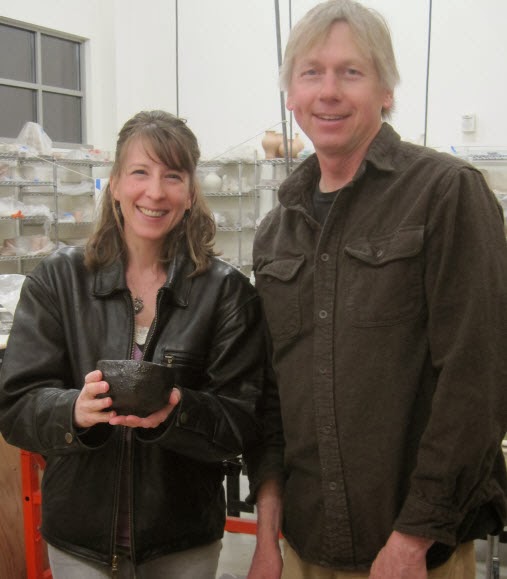Meet this gorgeous new tea bowl that has decided to come and live with me. I was very fortunate to be able to watch this bowl (hand made by potter Richard Brandt) come to life! It's a black Raku-style bowl, which is considered very formal in the Japanese Tea Ceremony. It is prized for its "wabi" aesthetic, its humbleness, simplicity and earthiness. I learned to call this Raku-style because "Raku" is actually a family name and true Raku bowls are those made by this family. Everything else is in the style of Raku. (And if this isn't what you think of as Raku, you're probably thinking of Western Raku, with its cobalt blue and other shiny colors. While sharing the same roots as traditional Raku, it's a different process.)
The bowl I chose was sitting in front of me, softly whispering my name
Raku is hand shaped rather than formed on a wheel. This makes each bowl clearly unique in shape and size. Those unique qualities get amplified when the bowl is coated with slip and then put into the kiln, where it's a mystery what will happen to the glaze and the ultimate character of the bowl! (Note that historical slip used lead, but this is lead free.) We were using the last of Richard's "Barnard slip", a special clay and recipe. There is no more of this slip to be had; the earth deposits have all been mined. It is with an extra sense of gratitude and responsibility for all that the earth gives us that I observed the process.
Richard is applying the Barnard slip
My bowl waiting to be fired
View from the top of the kiln.
The black shape is another tea bowl; the red glow is from the intense heat.
The kiln got up to over 1850 degrees (F). Seems pretty hot to me, and yet this is considered a low temperature firing! The result is a rather porous bowl. After 15 minutes or so of firing, Richard opens the kiln.
I literally gasped - it's so beautiful!
Bowls ready to be taken from the kiln
After a brief period of cooling, Richard takes the bowls - still glowing red - and dunks them into water.
Still glowing from the kiln
As the bowl enters the water, you see that it's black
A brave man; the water is steaming!
After a few moments, Richard reaches into the water and brings out the bowl. It's still quite hot!
My baby! Can you see that it's still steaming?
In my next post, I will share with you my first bowl of tea in this vessel and the naming of this bowl!












































